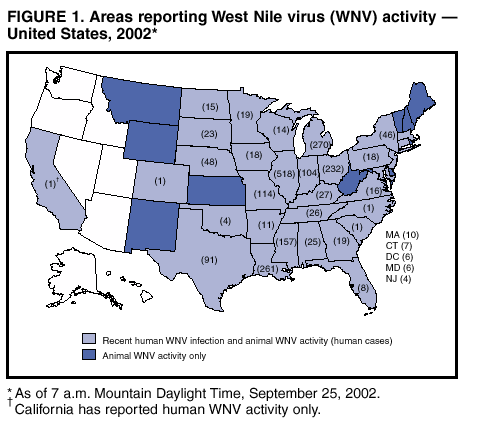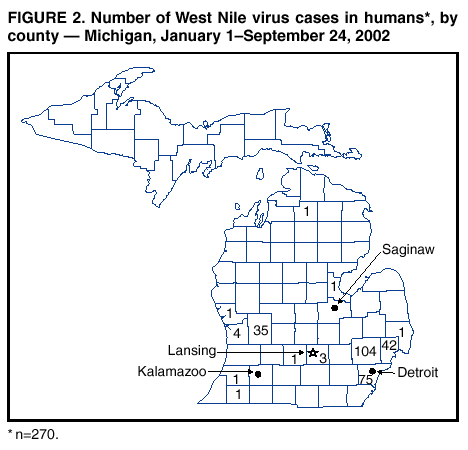 |
|
|
|
|
|
|
| ||||||||||
|
|
|
|
|
|
|
||||
| ||||||||||
|
|
|
|
|
Persons using assistive technology might not be able to fully access information in this file. For assistance, please send e-mail to: mmwrq@cdc.gov. Type 508 Accommodation and the title of the report in the subject line of e-mail. West Nile Virus Activity --- United States, September 19--25, 2002, and Michigan, January 1--September 24, 2002This report summarizes West Nile virus (WNV) surveillance data reported to CDC through ArboNET and by states and other jurisdictions as of 7 a.m. Mountain Daylight Time, September 25, 2002. United StatesDuring the reporting period of September 19--25, a total of 480 laboratory-positive human cases of WNV-associated illness were reported from Illinois (n=119), Michigan (n=104), Ohio (n=63), Indiana (n=26), Nebraska (n=25), Louisiana (n=23), Missouri (n=16), Pennsylvania (n=15), Mississippi (n=13), New York (n=11), Iowa (n=seven), Kentucky (n=seven), Texas (n=seven), Minnesota (n=six), North Dakota (n=six), Arkansas (n=five), South Dakota (n=five), Virginia (n=five), Alabama (n=four), the District of Columbia (n=three), Wisconsin (n=three), Georgia (n=two), Connecticut (n=one), Maryland (n=one), Massachusetts (n=one), New Jersey (n=one), and North Carolina (n=one). During this period, North Carolina reported its first human WNV case ever. During the same period, WNV infections were reported in 387 dead crows and 409 other dead birds. A total of 1,106 veterinary cases were reported: 1,099 equine, three canine, and four other species. During the same period, 377 WNV-positive mosquito pools were reported. During 2002, a total of 2,121 human cases with laboratory evidence of recent WNV infection have been reported from Illinois (n=518), Michigan (n=270), Louisiana (n=261), Ohio (n=232), Mississippi (n=157), Missouri (n=114), Indiana (n=104), Texas (n=91), Nebraska (n=48), New York (n=46), Kentucky (n=27), Tennessee (n=26), Alabama (n=25), South Dakota (n=23), Georgia (n=19), Minnesota (n=19), Iowa (n=18), Pennsylvania (n=18), Virginia (n=16), North Dakota (n=15), Wisconsin (n=14), Arkansas (n=11), Massachusetts (n=10), Florida (n=eight), Connecticut (n=seven), the District of Columbia (n=six), Maryland (n=six), New Jersey (n=four), Oklahoma (n=four), California (n=one), Colorado (n=one), North Carolina (n=one), and South Carolina (n=one) (Figure 1). Among the 1,814 patients for whom data were available, the median age was 55 years (range: 1 month--99 years); 963 (54%) were male, and the dates of illness onset ranged from June 10 to September 21. A total of 95 human deaths have been reported. The median age of decedents was 79 years (range: 27--99 years); 55 (58%) deaths were among men. In addition, 4,949 dead crows and 3,775 other dead birds with WNV infection were reported from 42 states, New York City, and the District of Columbia; 3,350 WNV infections in mammals (3,343 equines, three canines, and four other species) have been reported from 33 states (Alabama, Arkansas, Colorado, Delaware, Florida, Georgia, Illinois, Indiana, Iowa, Kansas, Kentucky, Louisiana, Maryland, Massachusetts, Minnesota, Mississippi, Missouri, Montana, Nebraska, New Jersey, New Mexico, New York, North Dakota, Ohio, Oklahoma, Pennsylvania, South Carolina, South Dakota, Tennessee, Texas, Vermont, Virginia, and Wyoming). During 2002, WNV seroconversions have been reported in 309 sentinel chicken flocks from Florida, Iowa, Nebraska, Pennsylvania, and New York City; 3,353 WNV-positive mosquito pools have been reported from 26 states (Alabama, Arkansas, Connecticut, Delaware, Georgia, Illinois, Indiana, Iowa, Kentucky, Maryland, Massachusetts, Mississippi, Missouri, Nebraska, New Hampshire, New Jersey, New York, North Carolina, Ohio, Pennsylvania, Rhode Island, South Carolina, South Dakota, Texas, Vermont, and Virginia), New York City, and the District of Columbia. MichiganDuring January 1--September 24, 2002, the Michigan Department of Community Health (MDCH) identified 270 persons with laboratory evidence of WNV infection; 236 cases were laboratory confirmed and 34 were probable. Thirteen cases were fatal; all 13 presented with either encephalitis or aseptic meningitis. The 270 patients had a median age of 61 years (range: 9 months--91 years); 157 (58%) were male. Of the 215 patients for whom clinical information was available, 184 (86%) had aseptic meningitis or encephalitis. The median age of these 184 cases was 67 years (range: 9 months--91 years). Median age of decedents was 79 years (range: 42--90 years). Date of illness onset for all cases was July 29--September 12. Of Michigan's 83 counties, 68 (82%) have reported WNV activity (positive animal, mosquito, or human cases). Human cases have occurred among persons in 13 counties, with 256 cases (95%), including all 13 deaths, occurring in the state's four most populous counties (Kent [35], Macomb [42], Oakland [104], and Wayne [75]) (Figure 2). Of 580 birds tested, 324 (56%) from 67 counties have tested positive for WNV by immunohistochemistry test and confirmatory polymerase chain reaction at state public health laboratories; the first bird tested positive on May 24. A total of 145 horses from 30 counties have tested laboratory positive. The first horse tested positive on August 16. MDCH provides daily updates on human cases of WNV on its website (http://www.michigan.gov/mdch), and animal case information is located on the Michigan Department of Agriculture (MDA) website (http://www.michigan.gov/mda). Results on specimens submitted for laboratory testing are provided electronically and by fax to patient providers, submitting laboratories, and local health departments. MDCH issues multiple press releases each week updating case numbers, reminding the public of personal protection measures, and advising elimination of sources of standing water around residences. Mosquito-control program recommendations, developed jointly by MDCH and MDA, are provided on the MDA website. The decision to initiate a control program has been left to local municipalities. The state has developed a surveillance system for report of side effects associated with mosquito spraying occurring as a component of WNV-control programs. Additional information about WNV activity is available from CDC at http://www.cdc.gov/ncidod/dvbid/westnile/index.htm and http://www.cindi.usgs.gov/hazard/event/west_nile/west_nile.html.
Figure 1  Return to top. Figure 2  Return to top.
Disclaimer All MMWR HTML versions of articles are electronic conversions from ASCII text into HTML. This conversion may have resulted in character translation or format errors in the HTML version. Users should not rely on this HTML document, but are referred to the electronic PDF version and/or the original MMWR paper copy for the official text, figures, and tables. An original paper copy of this issue can be obtained from the Superintendent of Documents, U.S. Government Printing Office (GPO), Washington, DC 20402-9371; telephone: (202) 512-1800. Contact GPO for current prices. **Questions or messages regarding errors in formatting should be addressed to mmwrq@cdc.gov.Page converted: 9/26/2002 |
|||||||||
This page last reviewed 9/26/2002
|